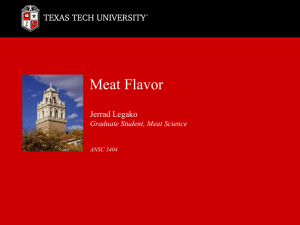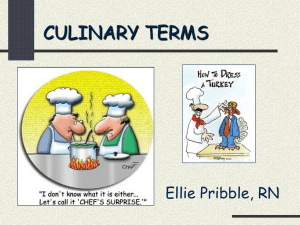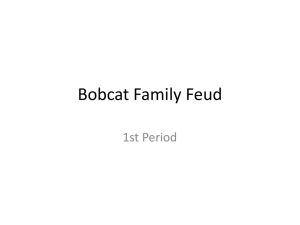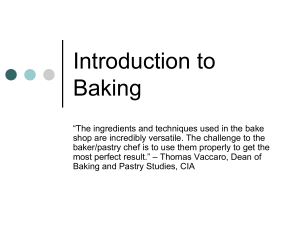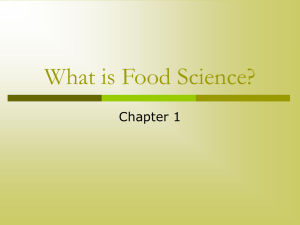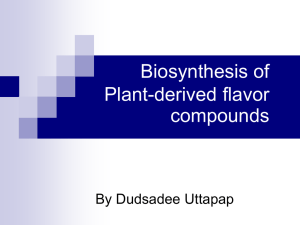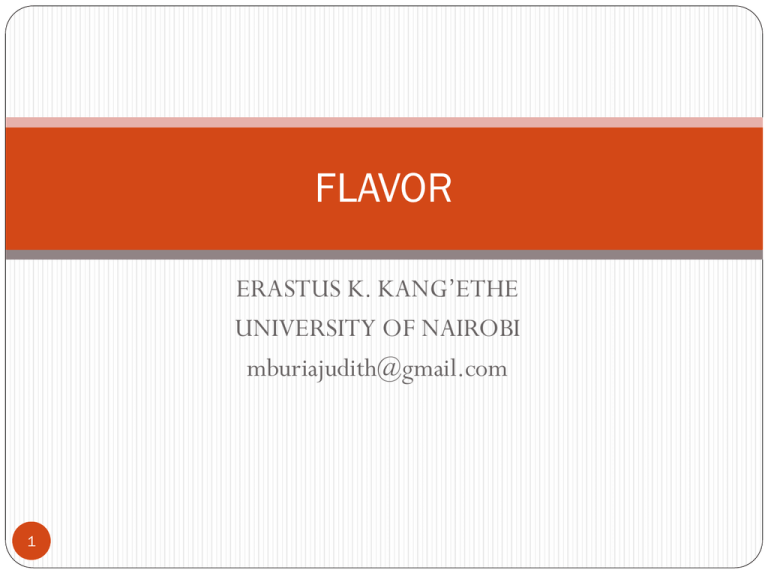
FLAVOR
ERASTUS K. KANG’ETHE
UNIVERSITY OF NAIROBI
mburiajudith@gmail.com
1
FLAVOR
• Flavour is a complex sensation. It involves sensations from taste,
smell and less defined from pressure sensitive areas of the mouth
• Uncooked meat has little odor and bloodlike taste. It is only
when cooked does the true flavor come out.
• Recent studies using aroma volatile compounds have improved
understanding of flavor but without the contribution from the
polar soluble compounds in juices the full understanding of flavor
is not complete
2
FLAVOR
• Fullness and satisfying fell of jiuces in the mouth plays a great
role in appreciation of flavor
Factors affecting flavor
• Species. Muscle proteins are similar and perform similar
biochemical functions. Differences in composition is very small.
• If one cooked lean meat from lamb, pork and beef there is no
species flavor differences noticed
3
FLAVOR
If one cooked fat tissue from lamb, pork and beef, typical
species flavor become evident.
GLC chromatograms from volatiles drawn from cooking fat
tissue of these three species yields identical peaks and no
single peak can be attributed to be responsible for the typical
species flavor
Fat acts a depot for flavor compounds
4
FLAVOR
Age. Typical flavor increases until maturity. Calves of 6
months do not have the same flavor intensity like mature
bulls at 12 months.
Breed. Few reports have shown differences in flavor of dairy
and beef breeds. The difference is in intensity than lack of
flavor
Sex. In the meat industry, objection to entire males for meat
is not founded except in pork.
5
FLAVOR
• Entire males have a better FCE, more lean to fat ratio and meats
with meat cuts with less fat.
• Pork from males used for breeding have a characteristic
objectionable off flavor called boar taint
• This is as a result of accumulation of 5α androst- 16-en-3one
(androstenone compound) in the fat
• At 6 months, 1ug/g or 1ppm is found in fat of such animals and
can be detected while cooking
6
FLAVOR
Diet. Feed contains naturally occurring odoriferous
compounds that contain hetero atoms of sulphur, oxygen or
nitrogen.
They are unsaturated but get modified by rumenal
dehydrogenation and are deposited in the aft as saturated
compounds.
7
FLAVOR
Diet before slaughter could affect flavor. Animals feed on
Lucerne the flavor due to Lucerne could be detected by
trained taste panelists.
Use of protected feed supplements could alter the flavor.
Compounds like linoleic acid protected in feeds by
formaldehyde treatment confer the meat fishy flavor.
8
FLAVOR
• Degree of fatness. Good fat cover and high degree of marbling
are not indicative or a guarantee of good flavor.
• Meat of different degree of fatness have no flavor differences
in rating except in flavor intensity
• Fat is essential for flavor and there is sufficient fat in the lean
for development of normal species flavor
9
FLAVOR
• pH effects. Meat of high pH like DCB has lower favor intensity
than meat of normal pH
• Storage. Meat stored at chill temperatures of 0-4oC
(conditioning) has increased favor intensity compared to
meat that is not conditioned. Conditioning increases the
release of volatiles(alkanes, pryazines, pyridines, benzonoids,
pyrolles and furans) which are flavor precursors
10
FLAVOR
• Frozen storage. Shelf life of frozen meats is determined by
organoleptic changes. These are mainly chemical and not microbial
• These are due to development of oxidative rancidity. Pork, veal
are more susceptible than beef.
• Attempts to prolong shelf lifee in beef has been attempted by
feeding vit. E protected supplements before slaughter. Vit. E is a
potent antioxidant
11
FLAVOR
Cooking Method. Method greatly influences final flavor.
Microwave cooking only releases one third of the volatiles
released during boiling.
Off flavors
Storage. There is loss of volatiles during storage. At -30oC
faint diacetyl odor is witnessed
12
FLAVOR
Sex odors. Review case of boar taint as an off odor
Feed. Taints from feed prior to slaughter are detectable by
panelists. Cattle fed on pastures sprayed with dieldrin give a
taint while those feeding on ragweed and have deficiency in
tryptohan metabolism have skatole taint
13
FLAVOR
Environment. Meat kept in vicinity of chemicals such as oils, paints
absorb these and are detected when cooked
Metabolic deficiency. Animals unable to excrete ketone and uremia
get tainted with these.
Management. Use of chemical insecticides and drugs prior to
slaughter without observing withdraw period can result in taints
14
FLAVOR
Heating. Cooking liberates H2S which reacts with mesityl
oxide to give the meat a catty odor
Irradiated foods. Irradiation liberates H2S mercaptans and
carbonyls which give meat a bitter stale taste.
15
Purpose
Understand factors that affect meat flavor and off flavors
References
Meat science 4th edition by Lawrie
Principles of meat science by Forrest et al
R.L.S Patterson “Meat flavor” in Meat edited by Cole and
Lawrie TS 1955 .E5 1974
16

